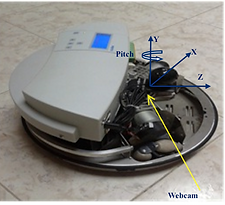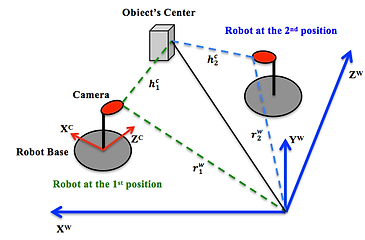Experimental Verification of Direct Depth Computing
Technique for Monocular Visual SLAM Systems
This work verifies our method of monocular depth computing in the context of visual SLAM. The closed form depth solution was exploited in the measurement model of a monocular EKF visual SLAM algorithm. SIFT interest points are tracked during camera motion and a suitable feature initialization is presented. The visual SLAM system is verified through experiments on Robotino mobile robot platform and the results are benchmarked to groundtruth.
[project]
[paper]

Monocular Depth from Motion Using a New Closed-Form Solution
Monocular depth has been found using estimation, closed-form solution and learning techniques. Estimation and closed-form solution compute the depth from motion, while learning techniques calculate the depth using a single image with a depth map as a supervisor. This paper presents a new closed form solution for monocular depth from motion. The proposed method builds on the notation that an interest point in an image of a static scene has a static world location. Camera pose and calibration parameters are used as constraints to provide the depth solution. The proposed method is verified through real experiments on Robotino mobile robot platform. The effect of uncertainty in the solution variables is studied and the results are benchmarked to groundtruth.
[paper]
[project]

Fast Template Matching of Objects for Visual SLAM
The majority of visual SLAM techniques utilize interest points as landmarks. Therefore, they suffer from two main problems; scalability and data association reliability. Recently, there has been increasing interest in using higher level object description to reduce the number of tracked features and improve the data association among frames. In this work, a simple visual mono SLAM algorithm is presented utilizing objects as landmarks and uses fast template matching to track predefined templates of these objects in an indoor environment. The results are described for real experiments with Robotino mobile robot platform. The performance of the proposed technique is evaluated and compared to recent methods.
[project]
[paper]

2010 - present
2010 - present
A Robust Nonlinear Controller for Autonomus Helicopter Landing
We consider the problem of controlling the vertical motion of a nonlinear model
of a helicopter during landing, while stabilizing the lateral and longitudinal
position and maintaining a constant attitude. The dynamics of the helicopter
main and tail rotors are often neglected to simplify the control design, but this
reduction has the disadvantage of an unreal choice of the control inputs. We
have solved this contradiction by choosing the main controller required for
performing the secure autonomous landing by neglecting the complex rotors
dynamics, and then we have included these important dynamics in a closed loop
model having real controls determined from an auxiliary controller. Simulation
results show the effectiveness of the method to cope with uncertainties on the
plant and actuator model.
[project]
